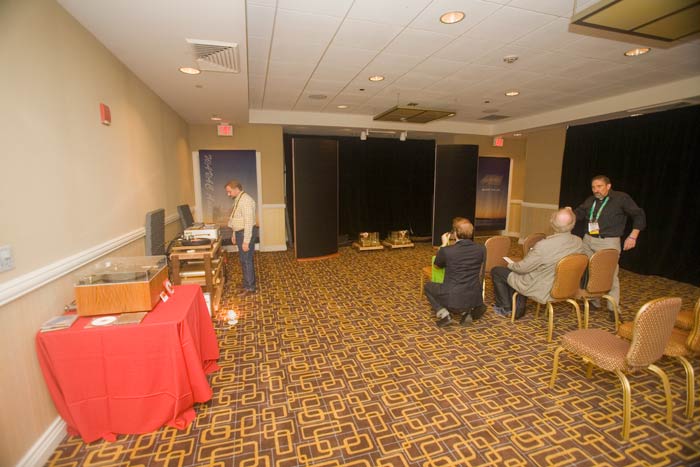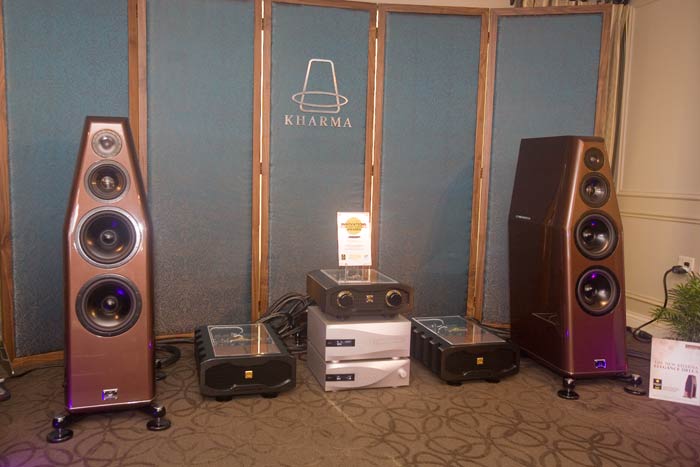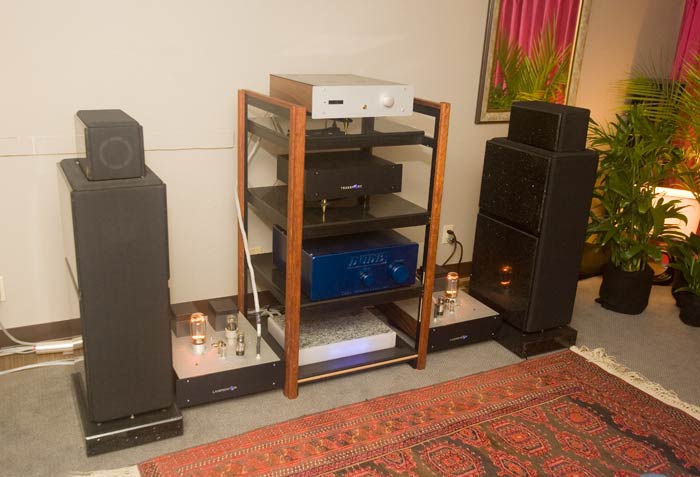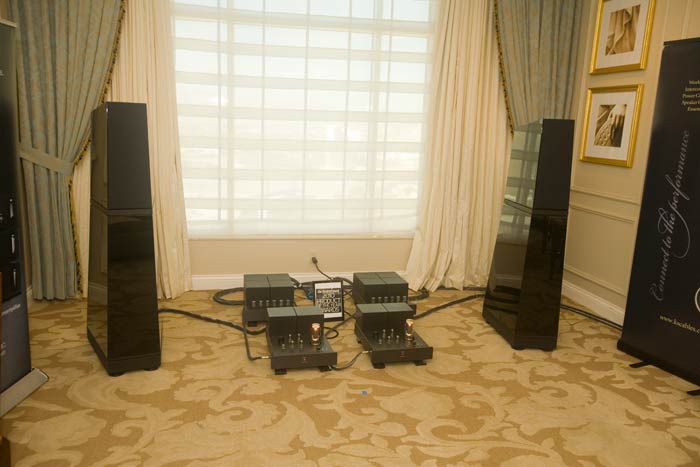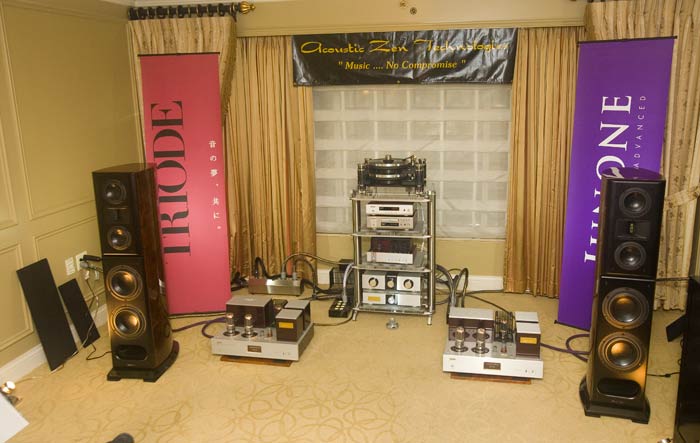There have been some interesting comments, by Myles Astor for one, on this system. I want to respond.
Some background.
We were SoundLab dealers for 6 or 7 years before we amicably went our own ways about 5 years ago. We have no relationship to WAVAC; not having a lot of success when we auditioned them and hear them at shows. We have no intention to start relationships anew as we are too freaking busy to tie our shoes it seems these days.
We are all about the sound. As we become more and more familiar with this industry [12 years now as dealer, importer, publisher, etailer, and curmudgeon (me!)], we have come to realize that we are in the minority. Most opinions you will hear are not based on sound but rather based on brand strength, advertising expenditures, appearance, technology, history, friendships, business relationships, storyline and/or the social aspects of the hobby. Not saying this is terrible but it does make for a wide range of opinions and performance characteristics out there.
We do not like a lot of the sound at shows. But when we do we feel it is important to speak up. Among all the loser sounds someone did a good job. Truly amazing [he says sardonically]. They should be roundly and publicly applauded in our opinion.
Our perspective on SoundLab is from the point of view of an ex-dealer who at one time wanted to sell a boatload of them to people because they really are an excellent sounding single driver speaker for seriously not a lot of money in today’s marketplace.
Typically people try to put inferior sounding [even if perhaps well-designed] solid-state amps on these speakers. These kinds of amps fail even more miserably at reproducing music on SoundLab speakers than they do on box speakers because the SoundLabs, and electrostatics in general, are so revealing. The SoundLabs are very revealing of just the types of flaws that that typically abound in these kinds of amps: overly aggressive note attacks [or artificially rolled-off attacks] and overly quick decays, leaving little time for the notes themselves. Combined with these kind of amps characteristic leanness, this makes the presentation harmonically barren and a difficult listening experience for the unconverted.
We tried many, many amps, from about $5K to $140K, on these speakers. If we were to pick a winner based on these experiments that is currently available and reasonably priced we would pick the Sanders amp. No relationship to this guy either except that he lives [last we heard] somewhere up in the woods about 50 or 60 miles south of us.
The MSB amps, seemingly one of the better solid-state amps out there, which were on the SoundLabs upstairs on floor 4 is a good example. All the details were there. And maybe the imaging and soundstage depth was excellent. I don’t know because it did not sound like music. There wasn’t the rushing swell of the notes and hypnotic decay that we get from real music. There wasn’t the harmonic content that real music has. Because of the way the notes are deformed by the amps, there is not that continuousness, no natural flow of one note to another, that like you would hear when you hit two notes on a musical instrument one after the other. It fundamentally just isn’t as engaging as a music reproduction should be, and sounds more like a very high end tinny-sounding radio.
Fine I guess if you are going to put them in a mancave and treat them as some sort of laboratory experiment [what can I say, electrostatic and panel speakers are cool. Single drivers are cool. Box-coloration-free sound is cool].
Getting tubes to work well on the SoundLabs has been the holy grail – its is all about getting these awesome speakers to sound more like real music [we first heard and picked up the SoundLab line at the Tuscany at THE Show 2002, when they were on those inexpensive powerhouse of a tube amp – called…. anybody? We forget the name of these. The brand folded soon thereafter. Ah. I remember. Wolcott I think they were called]. But most tube amps hated being put on these speakers. It.. was.. often… very… scary.
This has been the state [albeit slightly exaggerated] of the SoundLab speaker universe.
But the factory has been slowly but steadily improving the efficiency and design of the speakers, from even before we went our separate ways, and now we have the Majestic 945PX [or 845PX, but looks like the 9’s to us].
Before we talk about potential problems lets talk about what was right about the sound of the WAVAC-powered SoundLab system at THE Show 2014.
We were thre about 5 hours before closing. In this particular room I only heard the digital. I was walking around half the time and in the sweet spot several rows back the other half. Neli [I think she heard the analog], and sat out of the sweet spot [yes, yes, I usually am smart enough to sit off center as well, but I just wanted to luxuriate and get the full impact of the SoundLabs finally sounding wonderful].
* First, there were harmonics. Not overly done but enough so the brain did not have to spend a lot of cycles adding in harmonics that it knew were AWOL in the sound of your typical SoundLab speaker on solid-state amp sound. This meant the brain could relax a little bit and listen and enjoy the music more. It was rich, colorful and nuanced. The best we have heard from a WAVAC amp BTW.
* Second, there was excellent control of the notes. This meant that a) the attack and decay were much more lifelike, more round and finessed, like real notes, than what we had heard previously on the SoundLabs [and, better, in fact than the vast majority of the rooms at the show]. It also meant that the notes had more authority; they were more solid and substantial.
* Third, there was excellent separation. Separate notes stayed separate [as much as can be expected given the sources. We heard relatively complex music, but not, unfortunately, full on orchestral music].
These 3 characteristics by themselves put this room in the top sounding rooms at the show. These characteristics, combined with a reasonable frequency spread and reasonably linear response to frequency and dynamics, is what turns sound into music. Quite rare for systems to be this good [whether at shows, in dealerships or in people’s homes].
OK. So I posted that I liked this room on WhatsBestForum [I know, silly me]. Myles Astor responded with a embarrassingly negative [hey, been there done that] expansion of his negative comments that he posted in his show report on Positive Feedback:
“Did nothing for me. If your head wasn’t clamped in a vise, the imaging sucked and the instruments were stuck to the panels. Not to mention there was zero, read nada depth. SS was two dimensional. Also what happened to the upper octaves?”
Even if the things he implied by these general accusations were true, it would STILL be in the top sounds at the show [though I somehow missed the big Focal room and the Estelon room was locked the few times I went by there – doh! thank goodness it is anatomically difficult to kick oneself – both rooms which were in his top 3 rooms].
Let’s look at these one by one:
1. Head-in-a-vise. These are curved panels, not flat, so there is not inherent head-in-a-vise issues like the flat panel speakers out there [considering most people listen to their systems alone and in the sweet spot, this is usually not a problem. I listen with my wife … sometimes 🙂 …. so head-in-a-vise does not work for us].
I am not sure how wide the sweet spot was. I would guess about 6 feet side in a large room like this. Just guessing. These speakers have 30 degrees of curvature. If you want a wider sweet spot you can order your speakers with 45 degrees of curvature.
When I was walking around I certainly did not hear any instruments being stuck to the speakers or LRC [left, right, center] effects. This does have a tendency to annoy me as well, so, yeah, don’t want this kind of behavior.
2. Soundstage depth. Have to admit we are not soundstage depth junkies, although a lot of our friends are 🙂 As long as we can get a realistic soundstage with room for musicians and instruments to be more or less correctly sized [smaller speakers obviously have problems, as do close-miced instruments and voices] we are good. Yes, of course, we want deeper soundstages for orchestras and music like Radiohead [which plays with the depth of notes all of the time to wonderful and fun effect].
3. Upper octaves missing. I think MylesBAstor is pointing out that the part of the Soundlab panel that generates high frequencies is above ear level. These were taller SoundLabs [7 feet?]. We get a lot of our directional cues from these frequencies, and this is probably the root cause of at least some, if not most, of the issues Myles had in points #1 and #2.
In my photos of the SoundLab speaker base, the lows are at +0, mids at +0 and Brilliance at Max. This is good. But this is a huge room [see added photo]. In-room response will be much flatter in a smaller room with more reinforcement of the highs [and lows] depending on the liveness of your room. What we did here at the store a lot, because some of our rooms are also relatively big [but not this big!] is tilt the speaker, which normally tilts up a little, so that it tilts down a little, pointing the entire speaker to the level of the listener’s ears.
That said we did not have any problems with the directional cues or ‘higher octaves’ in this room. Probably because this is a ‘show’.
Excepting , you know, the ENIGMAcoustics super tweeter rooms, most rooms at the show weren’t showing off a heckuva lot of air.
So many rooms add damping and power conditioning to purposely roll off the treble as much as possible at shows. It is so easy for things to sound bright and harsh and for listeners. Listeners have a heightened sensititivity to those frequencies because they are tired, because they are listening so intently, and probably for lots of other reasons.
——————————————————————————-
Anyway, great sounding room. And this is why we thought it was in the top 2 or 3 rooms this year. Raises the bar for both SoundLab and WAVAC at future shows [just sayin’… :-)]. One of our original goals [which have evolved since then] for our dealership was to present the best of the 3 major speaker technologies for our visitor’s listening pleasure: cone drivers in boxes, panels (typically electrostatic), and horns. With this system the panel has caught up to the other two technologies. May the competition continue.
